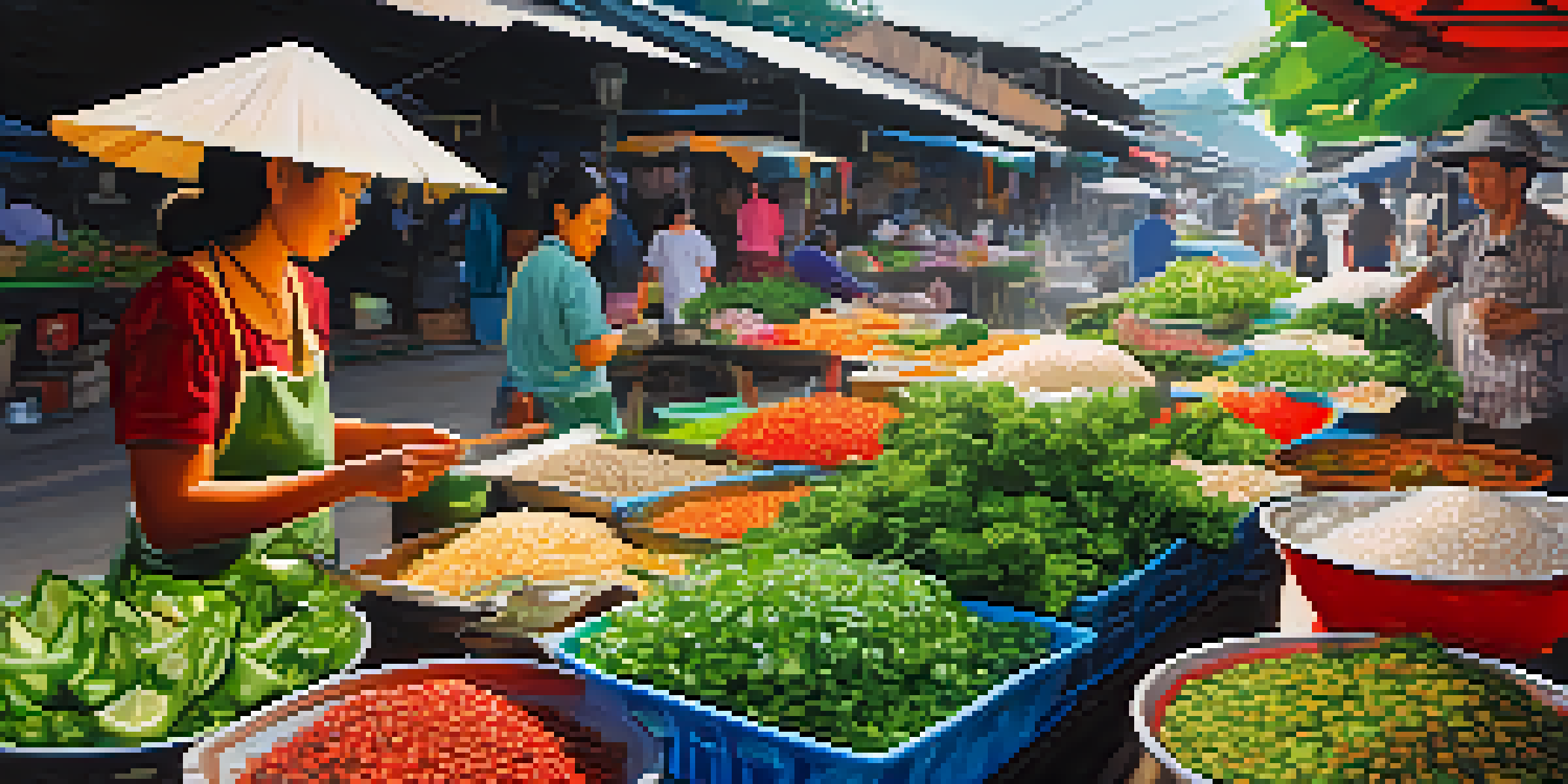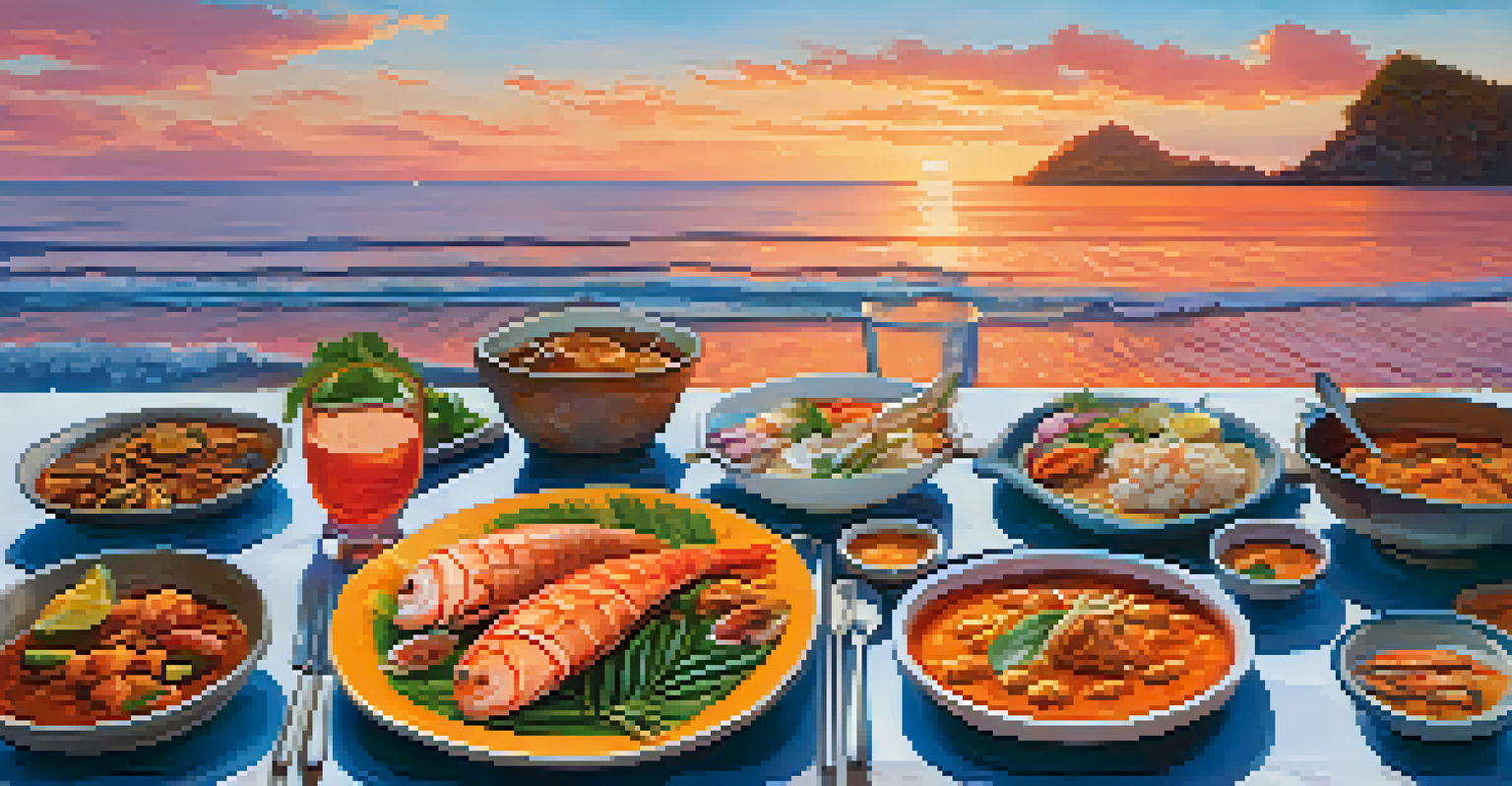The Influence of Geography on Thailand's Diverse Culinary Scene

Thailand's Geography: A Tapestry of Regions and Flavors
Thailand is a country where geography plays a crucial role in shaping its diverse culinary scene. Stretching from the mountainous north to the tropical south, each region boasts unique ingredients and cooking styles. For instance, the cooler climate in the north supports the growth of herbs and vegetables, which are often featured in dishes like Khao Soi, a spicy coconut curry noodle soup.
Food is an important part of a balanced diet.
In contrast, the southern region, with its access to the Andaman Sea and the Gulf of Thailand, is famous for its seafood. Here, you'll find dishes that highlight fresh fish, crab, and shrimp, often prepared with a blend of spices that reflect the local culture. This geographical diversity not only influences the ingredients but also the cooking techniques that define Thai cuisine.
Ultimately, Thailand's geography acts like a canvas, painting a vibrant picture of culinary diversity. Each region tells a story through its food, with flavors that are deeply rooted in local traditions and the environment, making Thai cuisine one of the most varied and exciting in the world.
Northern Thailand: Mountains, Herbs, and Unique Dishes
In Northern Thailand, the mountainous terrain and cooler climate foster a unique culinary identity. Here, dishes are often less spicy compared to the rest of the country, focusing instead on fresh herbs and vegetables. One popular dish, Larb, is a minced meat salad that incorporates mint, lime juice, and toasted rice, showcasing the region's fresh produce.

The use of local ingredients is a hallmark of northern cuisine, with sticky rice taking center stage. Families often gather around a basket of sticky rice, reflecting a communal dining culture that is integral to northern Thai life. This shared experience enhances the enjoyment of meals, making food not just about sustenance but also about connection.
Geography Shapes Thai Cuisine
Thailand's diverse culinary scene is influenced by its geography, with each region offering unique ingredients and cooking styles.
Moreover, the influence of ethnic minorities, such as the Karen and Hmong, adds another layer of complexity to Northern Thai cuisine. Their traditional practices and ingredients blend seamlessly with local flavors, creating dishes that are both authentic and diverse, making the northern food journey truly unique.
Northeastern Thailand: A Spicy Affair with Sticky Rice
Moving to Northeastern Thailand, or Isaan, we find a culinary scene renowned for its bold flavors and vibrant dishes. This region's cuisine often features fermented fish, spicy salads, and the beloved sticky rice, which serves as a staple accompaniment. Dishes like Som Tum, a green papaya salad, exemplify the region's penchant for heat and freshness.
The only thing I like better than talking about food is eating.
Isaan cuisine is heavily influenced by the agricultural lifestyle of its people. Farmers often prepare meals using local produce, which results in a diet rich in vegetables and herbs. The communal aspect of dining is evident here as well, with families sharing large platters of food, fostering a sense of unity and celebration.
Additionally, the proximity to Laos means that Isaan dishes often share similarities with Laotian cuisine. This cross-cultural exchange enriches the culinary offerings, making it a melting pot of flavors and techniques that are both exciting and deeply rooted in tradition.
Central Thailand: The Heart of Thai Cuisine
Central Thailand, often regarded as the heart of Thai cuisine, is home to Bangkok, a city rich in culinary innovation and tradition. The region showcases a harmonious blend of flavors, from sweet to salty, and dishes often incorporate coconut milk, fish sauce, and sugar. Classics like Pad Thai and Tom Yum reflect the balance and complexity that define Central Thai cooking.
The bustling street food scene in Bangkok serves as a testament to the region's culinary creativity. Vendors offer a variety of dishes that attract locals and tourists alike, making it a gastronomic hub. Here, you can enjoy everything from skewered meats to fresh fruit and desserts, all prepared with a focus on freshness and flavor.
Cultural Influences Enrich Flavors
Historical trade and cultural practices, including Buddhism, have significantly shaped the flavors and dishes found in Thai cuisine.
Central Thailand also prides itself on its royal cuisine, which has influenced many popular dishes today. This culinary legacy emphasizes presentation and intricate flavors, further enriching the diverse palate of this region. It's a place where tradition meets innovation, making every meal a delightful experience.
Southern Thailand: A Coastal Paradise of Spices and Seafood
Southern Thailand is a coastal paradise where the ocean's bounty meets an array of spices, creating a unique culinary landscape. The region is known for its rich and aromatic dishes, often featuring curry pastes made from fresh herbs and spices, which add depth and flavor. Signature dishes like Massaman curry highlight the use of coconut milk, peanuts, and a variety of meats, showcasing the region's vibrant palette.
The availability of fresh seafood plays a significant role in Southern cuisine. From grilled fish to spicy shrimp salads, the ocean's offerings are celebrated in many dishes. This reliance on local ingredients not only supports the community but also ensures that meals are bursting with freshness and flavor.
Moreover, the cultural influences from Malaysia and Indonesia are evident in Southern Thailand's dishes. This blend of flavors and techniques creates a culinary fusion that is unique to the region, making Southern Thai food both diverse and exciting. Each bite tells a story of the land, sea, and the people who call this place home.
The Role of Climate in Shaping Thai Ingredients
Climate is a significant factor influencing the types of ingredients grown in Thailand, which in turn shapes its culinary landscape. The tropical climate allows for a wide variety of fruits, vegetables, and herbs to flourish, providing chefs with a rich palette of flavors. This abundance contributes to the freshness that Thai cuisine is celebrated for, with dishes often centered around seasonal produce.
For instance, the hot and humid weather in the central and southern regions allows for the cultivation of herbs like basil and cilantro, which are staples in many Thai dishes. The use of these fresh ingredients not only enhances the flavor but also brings vibrant colors to the plate, making meals visually appealing.
Climate Affects Ingredient Variety
Thailand's tropical climate allows for a rich variety of fresh fruits, vegetables, and herbs, enhancing the flavors of its dishes.
Additionally, regional variations in climate lead to distinct culinary practices. In areas with higher rainfall, rice paddies thrive, ensuring that rice remains a staple across the country. Understanding the relationship between climate and agriculture helps to appreciate the depth of flavors present in Thai cuisine and the importance of seasonal cooking.
Cultural Influences: How History Shapes Thai Food
Thailand's rich history and diverse cultural influences play a pivotal role in shaping its culinary identity. Historical trade routes brought spices and ingredients from around the world, resulting in a cuisine that reflects a tapestry of flavors. For example, Indian spices and Chinese cooking techniques have significantly impacted Thai dishes, creating a unique fusion that is both familiar and exotic.
The influence of Buddhism is also evident in Thai cuisine, particularly in vegetarian dishes. Many Thais observe Buddhist practices that encourage mindful eating and a focus on plant-based ingredients. This has led to a variety of delicious vegetarian options that highlight local vegetables and herbs, further enriching the culinary diversity of the country.

Moreover, festivals and celebrations often revolve around food, showcasing the importance of culinary traditions in Thai culture. Dishes served during special occasions often have historical significance, bringing families together through shared meals that honor their heritage. This connection to history and culture is what makes Thai cuisine not just food, but a celebration of life.
Conclusion: The Culinary Journey Through Thailand's Regions
In conclusion, the influence of geography on Thailand's diverse culinary scene is profound and multifaceted. Each region, with its unique climate, ingredients, and cultural influences, contributes to a rich tapestry of flavors that delight the senses. From the mountains of the north to the beaches of the south, every bite tells a story of the land and its people.
Exploring Thai cuisine is like embarking on a culinary journey, where each dish represents a different aspect of the country's geography and history. It's an invitation to taste the diversity that makes Thailand a gastronomic treasure, with flavors that reflect both tradition and innovation.
So, whether you're enjoying a spicy salad from Isaan or a creamy curry from the south, you're not just eating; you're experiencing a piece of Thailand's rich cultural heritage. The next time you indulge in Thai food, take a moment to appreciate the geographical influences that make every dish a unique celebration of flavor.